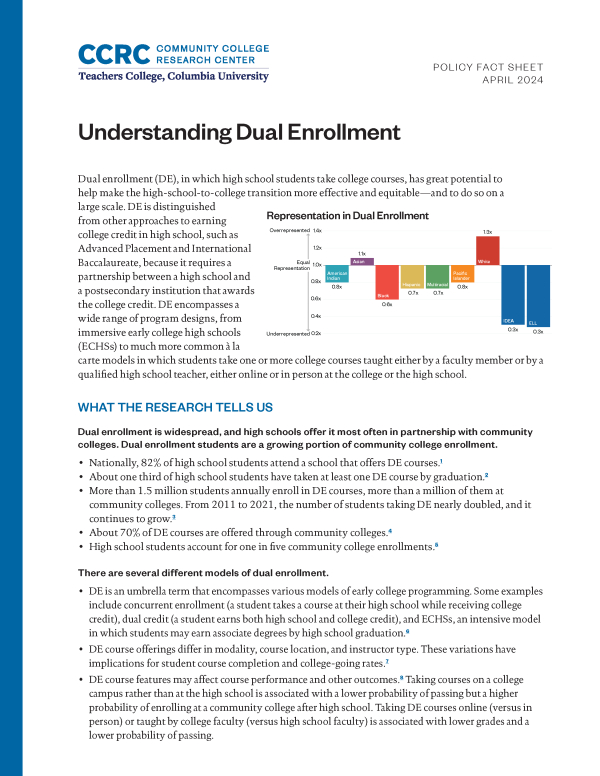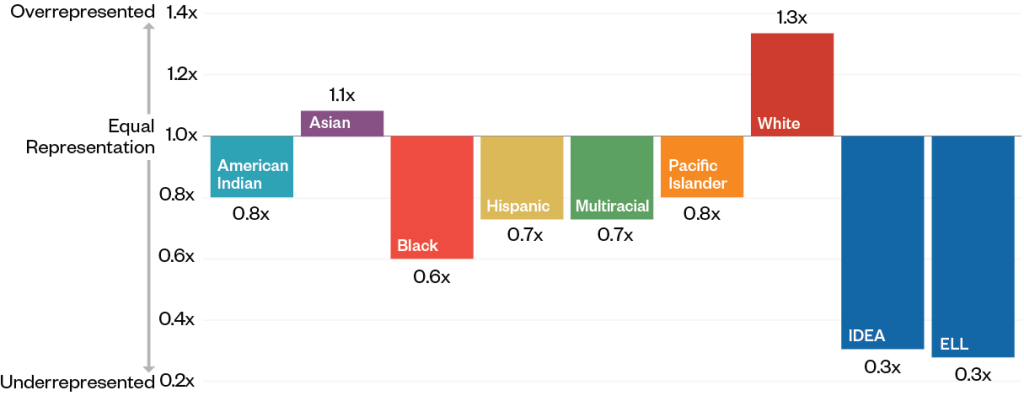
Dual enrollment (DE), in which high school students take college courses, has great potential to help make the high-school-to-college transition more effective and equitable—and to do so on a large scale. DE is distinguished from other approaches to earning college credit in high school, such as Advanced Placement and International Baccalaureate, because it requires a partnership between a high school and a postsecondary institution that awards the college credit. DE encompasses a wide range of program designs, from immersive early college high schools (ECHSs) to much more common à la carte models in which students take one or more college courses taught either by a faculty member or by a qualified high school teacher, either online or in person at the college or the high school.
Representation in Dual Enrollment

What the Research Tells Us
Dual enrollment is widespread, and high schools offer it most often in partnership with community colleges. Dual enrollment students are a growing portion of community college enrollment.
- Nationally, 82% of high schools offer DE courses.[1]
- About one third of high school students have taken at least one DE course by graduation.[2]
- More than 1.5 million students annually enroll in DE courses, more than a million of them at community colleges. From 2011 to 2021, the number of students taking DE nearly doubled, and it continues to grow.[3]
- About 70% of DE courses are offered through community colleges.[4]
- High school students account for one in five community college enrollments.[5]
There are several different models of dual enrollment.
- DE is an umbrella term that encompasses various models of early college programming. Some examples include concurrent enrollment (a student takes a course at their high school while receiving college credit), dual credit (a student earns both high school and college credit), and ECHSs, an intensive model in which students may earn associate degrees by high school graduation.[6]
- DE course offerings differ in modality, course location, and instructor type. These variations have implications for student course completion and college-going rates.[7]
- DE course features may affect course performance and other outcomes.[8] Taking courses on a college campus rather than at the high school is associated with a lower probability of passing but a higher probability of enrolling at a community college after high school. Taking DE courses online (versus in person) or taught by college faculty (versus high school faculty) is associated with lower grades and a lower probability of passing.
- The most prominent model for DE delivery is certified high school instructors teaching courses at the high school.[9]About 80% of DE students take college courses at their high school.[10]
Dual enrollment funding models vary widely across states, systems, and partnerships. Lowering tuition can lower barriers to access.
- DE is funded through a mix of state, local, K-12, and student/family sources. In many states and localities, community colleges also subsidize DE coursework through discounted or waived tuition and fees.[11]
- DE can be financially sustainable for colleges if they take advantage of economies of scale by increasing the number of students who participate and if they implement DE strategically to increase the rate at which DE students continue at their college after high school.[12]
- Discrete—or à la carte—DE tends to be less costly to school districts, colleges, and students than ECHS models.[13] ECHSs are designed to offer programming to students at low or no cost.
- States, systems, and partnerships have been aiming to reduce students’ tuition costs for enrolling in any type of DE programming to reduce barriers to access.[14]
Gaps in access to dual enrollment coursework can be traced to exclusionary policies and practices.
- White students participate in DE coursework at twice the rate of their Black and Hispanic classmates.[15][16] English learners and students with disabilities are also severely underrepresented in DE coursework.[17]
- Access to DE is highly variable within states and even among high schools in the same school district.[18]
- One in five districts report nearly equal or higher rates of participation in DE among Black and Hispanic students.[19]
- Colleges and schools tend to rely on standardized placement tests for eligibility, even though researchers question their validity as predictors of college readiness and raise concerns that they perpetuate inequities.[20]
High schools and colleges can make dual enrollment a more equitable on-ramp to a college program of study that leads to career-path employment for large numbers of students.
- There is strong evidence that DE—even à la carte DE—improves academic outcomes for students, including completing high school, enrolling in college, and completing college degrees.[21] And DE has been shown to benefit low-income students,[22] Black and Hispanic students[23][24][25], and students who initially struggled academically in high school.[26]
- DE partnerships with stronger results for low-income students and students of color[27][28]:
- engage in active outreach to underserved students and communities, building early awareness in middle school and through community-based organizations, and use alternatives to testing (e.g., high school grades) for eligibility requirements;
- align DE course offerings to postsecondary degree programs and embed DE coursework into
career-connected high school programs; - provide college advising to DE students to help them explore career interests and develop a preliminary college educational plan; and
- support student success through high-quality instruction and comprehensive academic supports.
Endnotes
- ^ National Center for Education Statistics (NCES). (2020). Dual or concurrent enrollment in public schools in the United States (Data Point: NCES 2020-125). U.S. Department of Education, Institute of Education Sciences.
- ^ Shivji, A., & Wilson, S. (2019). Dual enrollment participation and characteristics (Data Point: NCES 2019-176). U.S. Department of Education, Institute of Education Sciences, National Center for Education Statistics.
- ^ Fink, J., & Jenkins, D. (2023). Rethinking dual enrollment as an equitable on-ramp to a career-path college degree program after high school. Columbia University, Teachers College, Community College Research Center.
- ^ Fink & Jenkins (2023).
- ^ Barshay, J. (2023, July 24). Proof points: High schoolers account for nearly 1 out of every 5 community college students. The Hechinger Report.
- ^ Fink, J. (2023). Greater equity in college access through high school/college dual enrollment programs. The Campaign for College Opportunity.
- ^ Ryu, W., Schudde, L., & Pack-Cosme, K. (2023). Dually noted: Understanding the link between dual enrollment course characteristics and students’ course and college enrollment outcomes (CCRC Working Paper No. 134). Columbia University, Teachers College, Community College Research Center.
- ^ Ryu et al. (2023).
- ^ Shivji & Wilson (2019).
- ^ Shivji & Wilson (2019).
- ^ Fink & Jenkins (2023).
- ^ Fink & Jenkins (2023).
- ^ Taylor, J. L., Allen, T. O., An, B. P., Denecker, C., Edmunds, J. A., Fink, J., Giani, M. S., Hodara, M., Hu, X., Tobolowsky, B. F., & Chen, W. (2022). Research priorities for advancing equitable dual enrollment policy and practice. The University of Utah, Collaborative for Higher Education Research and Policy.
- ^ Zinth, J. (2019). Funding for equity: Designing state dual enrollment funding models to close equity gaps. College in High School Alliance.
- ^ Fink, J. (2021a, January 14). How equitable is access to AP and dual enrollment across states and school districts? The CCRC Mixed Methods Blog. Columbia University, Teachers College, Community College Research Center.
- ^ Xu, D., Solanki, S., & Fink, J. (2021). College acceleration for all? Mapping racial/ethnic gaps in Advanced Placement and Dual Enrollment participation. American Educational Research Journal, 58(5), 954–992.
- ^ Fink, J. (2021b, November 10). How many schools in your state shut out students from dual enrollment or AP? The CCRC Mixed Methods Blog. Columbia University, Teachers College, Community College Research Center.
- ^ Xu et al. (2021).
- ^ Xu et al. (2021).
- ^ Scott-Clayton, J., Crosta, P. M., & Belfield, C. R. (2014). Improving the targeting of treatment: Evidence from college remediation. Educational Evaluation and Policy Analysis, 36(3), 371–393.
- ^ Taylor et al. (2022).
- ^ For a review, see Appendix A3 in Taylor et al. (2022).
- ^ Liu, V., Minaya, V., & Xu, D. (2022). The impact of dual enrollment on college application choice and admission success (CCRC Working Paper No. 129). Columbia University, Teachers College, Community College Research Center.
- ^ Minaya, V. (2021). Can dual enrollment algebra reduce racial/ethnic gaps in early STEM outcomes? Evidence from Florida. Columbia University, Teachers College, Community College Research Center.
- ^ Liu, V., Minaya, V., Zhang, Q., & Xu, D. (2020). High school dual enrollment in Florida: Effects on college outcomes by race/ethnicity and course modality. Columbia University, Teachers College, Community College Research Center.
- ^ Lee, H. & Villarreal, M. U. (2022). Should students falling behind in school take dual enrollment courses? Journal of Education for Students Placed at Risk (JESPAR), 28(4), 439–473.
- ^ Fink, J., Griffin, S., Garcia Tulloch, A., Jenkins, D., Fay, M. P., Ramirez, C., Schudde, L., & Steiger, J. (2023). DEEP insights: Redesigning dual enrollment as a purposeful pathway to college and career opportunity. Columbia University, Teachers College, Community College Research Center.
- ^ Mehl, G., Wyner, J., Barnett, E. A., Fink, J., & Jenkins, D. (2020). The dual enrollment playbook: A guide to equitable acceleration for students. Columbia University, Teachers College, Community College Research Center.

